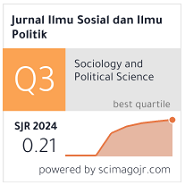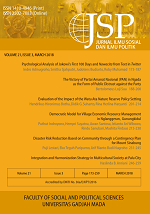Assessing the Evolution of Maritime Strategy in the Asia Pacific
Buddy Suseto(1), Zarina Othman(2*), Farizal Mohd Razalli(3)
(1) Faculty of Humanities and Social Sciences, Universiti Kebangsaan Malaysia
(2) Faculty of Humanities and Social Sciences, Universiti Kebangsaan Malaysia
(3) Faculty of Humanities and Social Sciences, Universiti Kebangsaan Malaysia
(*) Corresponding Author
Abstract
The end of the Cold War has provided an opportunity for scholars to do an in-depth study on the concept of maritime security, especially in the Asia Pacific region. One of the most important but often neglected concepts is maritime strategy which has been developing for centuries. Maritime strategy is designed for states’ survival and to protect their national interests. Nevertheless there is no ‘one size fits all’ concept. Therefore, the purpose of this article is to analyse the similarities and differences between continental states such as the United States, and India, and maritime states such as Indonesia, Japan, Australia, and Singapore in implementing their maritime strategy. In an attempt to present the results, we have reviewed secondary data mainly from the literature written by scholars in the field. Preliminary findings suggests that countries, either continental or maritime states, designed their maritime strategy for national security reasons. States aim to survive in the unknown international political arena. However, domestic and socioeconomic factors such as economic growth, geostrategic interest as well as nature of threats, may have shaped differences among states’ maritime strategy. The emerging non-traditional threats such narcotic trafficking, terrorism and human smuggling, have contributed to the threats for many states, this further justifies the importance of maritime strategy.
Keywords
Full Text:
PDFReferences
Adiwan, F. A. (2017). Special economic zone at the crossroads: The case of Batam. Jurnal Ilmu Sosial dan Ilmu Politik, 21(2), 132–146. http://doi.org/10.22146/jsp.30438
Bateman, W., & Sherwood, R. (1992). Principles of Australian maritime operations (No. 265). Canberra. Retrieved from http://www.navy.gov.au/sites/default/files/documents/Principle_of_Aust_Maritime_Operations_265_opt.pdf
Baer, G. W. (1994) One Hundred Years of Sea Power: The US Navy, 1890–1990. Stanford: Stanford University Press.
Benner, S. M. (2004). Evolution of maritime strategy…is sea power 21 the answer? Carlisle: Pennsylvania.
Booth, K. (1977). Navies and foreign policy. London: Croom Helm.
Britain MoD. (2011). Joint doctrine publication 0-10 British maritime doctrine. Swindon. Ministry of Defence. Retrieved from www.mod.uk/dcdc
British Government. (2014). The UK national strategy for maritime security. London: Williams Lea Group. Retrieved from www.gov.uk/government/publications
Bruns, S. (2014). U.S. Navy strategy & American sea power from “The Maritime Strategy” (1982-1986) to “A Cooperative Strategy for 21st Century Seapower” (2007). Kiel University
Buddy, S., Zarina, O., & Farizal, M. R. (2018). The Need to reform Indonesia’s maritime strategy: A Review. Indonesian Journal of Geography, 50(2), 145–153. http://doi.org/http://dx.doi.org/10.22146/ijg.27954
Cable, J. (1983). Britain’s naval future (First). London: The Macmillan Press Ltd.
Chandramohan, B. (2016). India’s evolving maritime security strategy and force posture. Future Directions International, 2015, 2–8. Retrieved from http://www.futuredirections.org.au/wp-content/uploads/2016/03/India’s-Evolving-Maritime-Security-Strategy-and-Force-Posture.pdf
Corbett, J. S. (1911). Some principles of maritime strategy. London: Project Gutenberg.
Cropsey, S., & Mcgrath, B. (2018). Maritime strategy in a New Era of Great Power competition. Washington D.C.: Hudson Institute.
Dhowan, R. (2015). Ensuring secure seas: Indian maritime security strategy. (J. S. S. Sanjay J Singh, NM, Sarabjeet S Parmar, Ed.). New Delhi: Integrated headquarters, Ministry of Defence (Navy). Retrieved from http://indiannavy.nic.in/sites/default/files/Indian_Maritime_Security_Strategy_Document_25Jan16.pdf
Djalal, H. (2013). Pengelolaan batas maritim dan kawasan perbatasan: Menentukan batas negara guna meningkatkan pengawasan, penegakan hukum dan kedaulatan NKRI. Jurnal Pertahanan, 3(3), 17–39.
Donohue, H. (2000). The oceans and Australia’s defence. In D. Wilson & D. Sherwood (Eds.), Oceans Governance and Maritime Strategy (p. 246). Sydney: Allen & Unwin.
Forward, C. (2009). Archipelagic Sea-Lanes In Indonesia - Their Legality In International. Australian & New Zealand Maritime Law Journal, 23(2), 143–156.
Gardner, J. (2006). British naval thinking and technology in the Second World War. In G. Till (Ed.), The Development of British Naval Thinking, 214. New York: Routledge Taylor & Francis Group. http://doi.org/10.4324/9780203485620
Gough, B. M. (1988). Maritime strategy: The legacies of Mahan and Corbett as philosophers of sea power. RUSI Journal, 133(4), 55–62. doi: 10.1080/03071848808445330
Grove, E. (1990). The future of sea power. London: Routledge.
Grove, E. (2006). The discovery of doctrine British naval thinking at the close of the twentieth century. In G. Till (Ed.), The Development of British Naval Thinking (pp. 182–191). New York: Taylor and Francis.
Hattendorf, J. B. (1989). Maritime strategy and the balance of power: Britain and America in the twentieth Century. In J. B. Jordan, B. Hattendorf, & O’Neil Robert (Eds.), Maritime strategy and the balance of power britain and america in the twentieth century (p. 373). New York: Palgrave Macmillan.
Hattendorf, J. B. (2013). What is a maritime strategy? (No. 1). Soundings. Canberra. Retrieved from http://www.navy.gov.au/sites/default/files/documents/Soundings 1 - Hattendorf - What is a Maritime Strategy.pdf
Hattendorf, J. B., Phil, D. (2004). The evolution of the U.S. Navy’s maritime strategy, 1977-1986. Newport, Rhode Island: Naval War College.
Heuser, B., & Cambridge University Press. (2010). The evolution of strategy: Thinking war from antiquity to the present. New York: Cambridge University Press.
Hill, R. (2000). Medium power strategy revisited. In Sea Power Centre-Australia Working Paper.
Ho, J. (2008). The U.S. maritime strategy: A cooperative strategy for 21 st Century Seapower. RSIS Commentaries. Singapore: RSIS. Retrieved from https://www.rsis.edu.sg/wp-content/uploads/2014/07/CO08081.pdf
Hongzhou, B. Z. (2015). Indonesia’s war on illegal fishing: Impact on China. RSIS Commentaries, (192), 2013–2015. Retrieved from https://www.files.ethz.ch/isn/194173/CO15192.pdf
Hoyt, T. D. (2007). The United States and maritime strategy: A parochial view from the U.S. Naval War College. Elsevier, 51(4), 577–584. doi: 10.1016/j.orbis.2007.08.003
Kainikara, S. (2013). Air force in a maritime strategy: Challenges and opportunities. In J. Jones (Ed.), A maritime school of strategic thought for Australia: perspectives (pp. 107–111). Sea Power Centre - Australia. doi: 10.1080/19480881.2014.882116
Kaneda, H. (2002). Japan’s maritime strategy in the new era. In J. Schwarz, W. A. Herrmann, & H.-F. Seller (Eds.), Maritime strategies in Asia (pp. 241–263). Bangkok: White Lotus Press.
Keliat, M. (2009). Keamanan maritim dan implikasi kebijakannya bagi Indonesia. Jurnal Ilmu Sosial Dan Ilmu Politik, 13(1), 19. doi: 10.22146/jsp.10970
Klein, J. J. (2004). Corbett in orbit: A Maritime Model for strategic space theory. Naval War College Review, (1), 60–74.
Kraska, J. (2012). America’s maritime challenges and priorities The Asian dimension. In J. H. Ho & S. Bateman (Eds.), Maritime challenges and priorities in Asia (p. 320). New York: Routledge Taylor & Francis Group. http://doi.org/https://doi.org/10.4324/9780203116272
Mahan, A. T. (1889). The Influence of Sea Power Upon History 1660-1783. Boston: Little Brown and Company.
Mangindaan, R. (2002). Maritime strategy of Indonesia in 2000-2010. In J. Schwarz, W. A. Herrmann, & B. Seller (Eds.), Maritime Strategies in Asia (pp. 325–337). Bangkok: White Lotus Press.
Marsetio. (2014). Sea power Indonesia (Pertama). Jakarta: Universitas Pertahanan.
McCaffrie, J. (2006). Positioning navies for the future: Challenge and response. In J. McCaffrie (Ed.), Proceedings of the Royal Australian Navy Sea Power Conference 2004 (p. 274). New South Wales: Sea Power Centre-Australia and Halstead Press.
Melda, K. A. (2009). Maritime security in South East Asia: Indonesian. HeinOnline, (May), 88–102. Retrieved from https://www.copyright.com/ccc/basicSearch.do? &operation=go&searchType=0
Menon, R. (1998). Maritime strategy and continental wars (First). London: Frank Cass.
Mière, C. Le. (2013). A maritime school of strategic thought. In J. Jones (Ed.), A maritime school of strategic thought for Australia: perspectives (pp. 75–79). Sea Power Centre - Australia. http://doi.org/10.1080/19480881.2014.882116
Morrison, D. (2011). Speech to RAN maritime conference. Retrieved April 18, 2017, from http://103.11.78.168/~/media/Files/Speeches/Speech_to_Maritime_Conference.pdf
Nor Azizan, I., & Zarina, O. (2009). From “non-interference” to “constructive engagement”: Contemporary Malaysia-Myanmar relations. Tamkang Journal of International Affairs, XII(IV), 1–42. http://dx.doi.org/ 10.6185/TJIA.V
Percy, S. (2013). Maritime strategy in a world of pervasive insecurity. In A. Forbes (Ed.), Naval diplomacy and maritime power projection maritime power projection (pp. 121–133). Sea Power Centre - Australia. Canberra, Australia: Sea Power Centre-Australia.
Rotte, R. (2002). Maritime strategy of Singapore. In J. Schwarz, W. A. Herrmann, & H.-F. Seller (Eds.), Maritime strategies in Asia (pp. 391–410). Bangkok: White Lotus Press.
Rubel, R. C. (2015). The home fleet: Pivot of maritime strategy. Corbett Paper, 16(4), 17.
Salim, C. (2015). A pathway to Indonesia’s maritime future: the role of maritime policy, doctrine and strategy. Canberra: Sea Power Center-Australia. Retrieved from http://www.navy.gov.au/sites/default/files/documents/Soundings_No_5.pdf
Scott, H. B. M. (2004). Australia’s maritime strategy. Parliament of Australia. Canberra. Retrieved from http://www.aph.gov.au/parliamentary_business/committees/house_of_representatives_committees?url=jfadt/maritime/report.htm
Sebastian, L. C., Supriyanto, R. A., & Arsana, I. M. A. (2014). Indonesia and the Law of the Sea: Beyond the archipelagic outlook. In C. B. Roberts, A. D. Habir, & L. C. Sebastian (Eds.), Indonesia at Home and Abroad Economics, Politics and Security (p. 125). Canberra: The Australian National University.
Setianegara, H. (2014). Strategi maritim pada perang laut nusantara dan poros maritim (Pertama). Yogyakarta: Leutikaprio.
Speller, I. (2005). Naval Diplomacy: Operation Vantage, 1961. In I. Speller (Ed.), The Royal Navy and Maritime Power in The Twentieth Century (pp. 164–180). New York: Frank Cass.
Sugiarto, P., Anna, Y. H., & Adi, J. P. (2017). Potential conflict among ASEAN member states in the implementation of The ASEAN Economic Community. Jurnal Ilmu Sosial dan Ilmu Politik, 20(3), 236–248. doi: 10.22146/jsp.27208
Suropati, U., Sulaiman, Y., & Montratama, I. (2016). Arungi samudra bersama sang naga: sinergi poros maritim dunia dan jalur sutra maritim abad ke-21. Jakarta: PT Gramedia Jakarta.
Swartz, P. M. (2005). US Navy Capstone Strategies & Concepts (1974-2005). Retrieved November 4, 2017, from http://ibiblio.org/hyperwar/NHC/Capstone/USN Strategies and Concepts - 1974-2005/USN Strategies and Concepts - 1974-2005.html
Taylor, P. D. (2008). Perspectives on Maritime Strategy. (P. D. Taylor, Ed.). Newport, Rhode Island: Naval War College Press.
Till, G. (1984). Maritime Strategy and the Nuclear Age (second). London: Macmillan Academic and Professional Ltd.
Till, G. (1994). Maritime strategy and the twenty ‐ first century. Strategic Studies, 17(1), 176–199. doi: 10.1080/01402399408437545
Till, G. (2005). Sea power a guide for the Twenty-First Century. London: Frank Cass.
Till, G. (2006). Corbett and the emergence of a British school? In G. Till (Ed.), The Development of British Naval Thinking (pp. 60–88). New York: Routledge Taylor & Francis Group.
Till, G. (2008). Maritime strategy and the Twenty-First Century. Journal of Strategic Studies, 17(1), 176–199. http://doi.org/10.1080/01402399408437545
Till, G. (2009). Seapower a guide for the Twenty-First Century (Kedua). Oxon: Routledge Taylor & Francis Group.
Till, G. (2013). A maritime strategy for Australia. In J. Jones (Ed.), A maritime school of strategic thought for Australia: perspectives (pp. 58–61). Sea Power Centre - Australia.
Till, G. (2015). Indonesia as a growing maritime power: Possible implications for Australia. Soundings, (4), 11. Retrieved from http://www.navy.gov.au/sites/default/files/documents/Soundings_No_4.pdf
Turner, V. A. S. (2001). Missions of The U.S. Navy Sea Control Study Navy. CIA.
U.S. Navy. (2015). A cooperative strategy for 21st century Seapower. Retrieved from https://www.uscg.mil/seniorleadership/DOCS/CS21R_Final.pdf
Vego, M. (2009). Naval Classical Thinkers and Operational Art. Newport: Naval War College United States.
Wiley, J. (2016). America, Sea Power, and the World. (J. C. Bradford, Ed.) (First). Chichester: Wiley Blackwell.
Williams, J. (2008). Mahan, Corbett, Douhet and Mitchell: The naval and air theorists. Retrieved January 23, 2017, from https://severalfourmany.files.wordpress.com/2015/09/mahan-corbett-douhet-and-mitchell.pdf
Zarina, O., Nasuha, N. R. N. A. J., & Halim, A. M. (2013). Non-Traditional Security Issues and the Stability of Southeast Asia. Jurnal Kajian Wilayah LIPI, 4(2), 150–164. doi: 10.14203/jkw.v4i2.265
Article Metrics
Refbacks
- There are currently no refbacks.
Copyright (c) 2019 Jurnal Ilmu Sosial dan Ilmu Politik

This work is licensed under a Creative Commons Attribution-NonCommercial-NoDerivatives 4.0 International License.






















